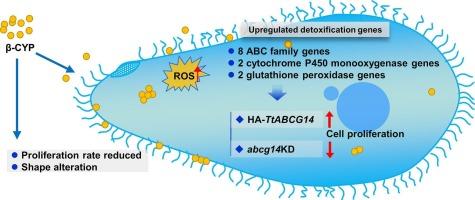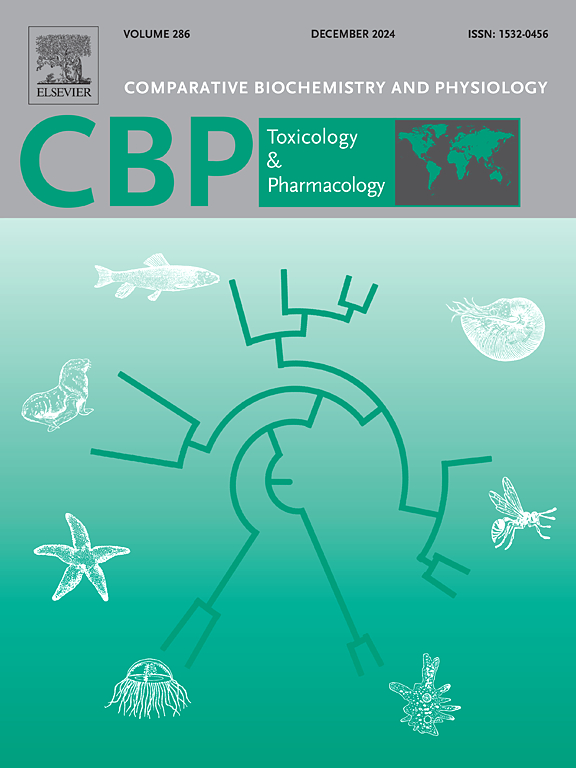嗜热四膜虫体内β-氯氰菊酯诱导的应激反应和ABC转运体介导的解毒作用
IF 3.9
3区 环境科学与生态学
Q2 BIOCHEMISTRY & MOLECULAR BIOLOGY
Comparative Biochemistry and Physiology C-toxicology & Pharmacology
Pub Date : 2024-11-06
DOI:10.1016/j.cbpc.2024.110066
引用次数: 0
摘要
β-氯氰菊酯(β-CYP)是一种合成的拟除虫菊酯杀虫剂,被广泛用于昆虫管理。然而,它也会影响非目标生物并污染水生生态系统。嗜热四膜虫是淡水中的一种单细胞纤毛原生动物,与水生环境直接接触,对环境变化非常敏感。在β-CYP胁迫下,嗜热四膜虫的增殖受到抑制,细胞形态发生变化。细胞内 ROS 水平显著升高,SOD 活性随 β-CYP 浓度的增加而逐渐升高。在 25 mg/L β-CYP 胁迫下,687 个基因上调,主要富集在有机环化合物结合和杂环化合物结合途径中。这些基因包括 8 个 ATP 结合盒转运体(ABC)家族基因、2 个细胞色素 P450 单氧化酶基因和 2 个谷胱甘肽过氧化物酶相关基因。其中,ABCG14基因敲除会影响β-CYP胁迫下的细胞增殖。相反,ABCG14的过表达增强了细胞对β-CYP的耐受性。结果表明,四膜虫通过各种解毒机制耐受高浓度的β-CYP胁迫,其中ABCG14在β-CYP的解毒过程中发挥着关键作用。本文章由计算机程序翻译,如有差异,请以英文原文为准。

Beta-cypermethrin-induced stress response and ABC transporter-mediated detoxification in Tetrahymena thermophila
β-Cypermethrin (β-CYP), a synthetic pyrethroid pesticide, is widely used for insect management. However, it also affects non-target organisms and pollutes aquatic ecosystems. Tetrahymena thermophila, a unicellular ciliated protist found in fresh water, is in direct contact with aquatic environments and sensitive to environmental changes. The proliferation of T. thermophila was inhibited and the cellular morphology changed under β-CYP stress. The intracellular ROS level significantly increased, and SOD activity gradually rose with increasing β-CYP concentrations. Under 25 mg/L β-CYP stress, 687 genes were up-regulated, primarily enriched in the organic cyclic compound binding and heterocyclic compound binding pathways. These include 8 ATP-binding cassette transporters (ABC) family genes, 2 cytochrome P450 monooxygenase genes, and 2 glutathione peroxidase related genes. Among of them, ABCG14 knockdown affected cellular proliferation under β-CYP stress. In contrast, overexpression of ABCG14 enhanced cellular tolerance to β-CYP. The results demonstrated that Tetrahymena tolerates high β-CYP concentration stress through various detoxification mechanisms, with ABCG14 playing a crucial role in detoxification of β-CYP.
求助全文
通过发布文献求助,成功后即可免费获取论文全文。
去求助
来源期刊
CiteScore
7.50
自引率
5.10%
发文量
206
审稿时长
30 days
期刊介绍:
Part C: Toxicology and Pharmacology. This journal is concerned with chemical and drug action at different levels of organization, biotransformation of xenobiotics, mechanisms of toxicity, including reactive oxygen species and carcinogenesis, endocrine disruptors, natural products chemistry, and signal transduction with a molecular approach to these fields.

 求助内容:
求助内容: 应助结果提醒方式:
应助结果提醒方式:


